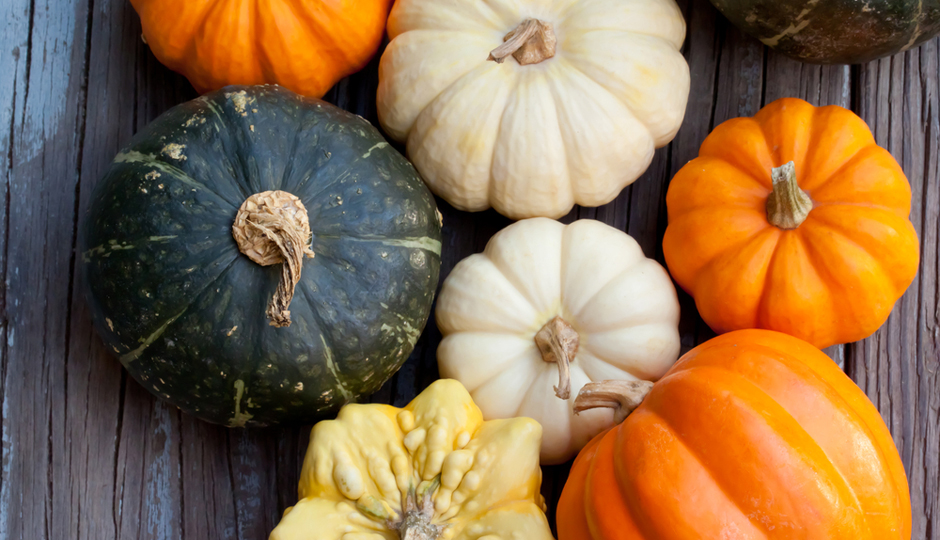10 Fall Fruits and Veggies We Can’t Wait to Eat

Shutterstock
The summer season gets a lot of love when it comes to produce. It’s the time of year, of course, when you can get strawberries, tomatoes and corn so sweet and delicious, you can (and probably, do) eat them for dessert. But just because summer is now officially behind us doesn’t mean you have to mourn the end of tasty fruits and veggies. Fall comes with its own haul that’s pretty darn amazing, too.
Don’t believe me? Check out the goodies that’ll be hitting the produce section in the coming weeks and months, and bookmark the following recipes for your fall kitchen adventures. Then say it with me: Adios, summer.
Brussels sprouts
In season: September through November
Why they’re awesome: Brussels (yes, with an “s”) have the vitamin C game down pat. A cup of sprouts has over 120 percent of your daily dose. They’re also a good source of fiber and low in calories.
How to eat them: Rough chop and sauté them with a splash of olive oil, lemon juice and almond slivers for five to 10 minutes on medium heat. Or, you can always roast them.
Cranberries
In season: October through December
Why they’re awesome:Another vitamin C powerhouse, with antioxidants and phytonutrients, both of which help block cell-damaging free radicals.
Hot to eat them: How good does a cranberry-avocado salsa sound? Dip with pita chips.
Escarole
In season: September and October
Why it’s awesome: This slightly bitter leafy lettuce (also called endive, as it’s a type of endive) kills it in the vitamin K department. It’s also a great source of vitamin A.
Hot to eat it: Most everyone throws it in a soup with white beans, but your challenge this year is to make something completely out of the ordinary. How about these salmon and escarole steamer pouches?
Fennel
In season: October and November
Why it’s awesome: Go for the fresh stuff, not the dried seeds. All parts of the fennel plant—from bulb to stalk to fronds—are edible and delicious. They also pack some vitamin C and fiber.
Hot to eat it: Here’s a terrific guide that explains how to use the entire plant, but the bulbs can be roasted and topped with parmesan for a delicious side dish.
Grapes
In season: September and October
Why they’re awesome: Fun fact: Pennsylvania is apparently the fifth largest producer of grapes in the country, with a large supply of flavorful concord grapes coming from the state’s northwestern corner. Grapes are low in calories, making them a wise snack for sweet-tooths, and contain phytonutrients, too.
Hot to eat them: You can easily slice them up and add them to any salad, or go with the one-two fall-produce punch with this grapes and Brussels sprouts recipe.
Fall apple varieties
In season: September to October
Why they’re awesome: I couldn’t pick just one. (And neither can you—check out our fall apple-picking guide.) The multitude of apple varieties available in our region this time of year is mind boggling. In general, apples are a swell source of fiber and vitamin C. Just make sure you eat the skin, too: That’s where the fruit’s stock of polyphenols (antioxidants) are highly concentrated.
Hot to eat them: If you love apple pie, you’ll love this lightened up apple pie in an apple. Smart!
Pumpkins
In season: October and November
Why they’re awesome: No, they’re not just for carving—pumpkins are for eating, too. (If you’ve never roasted pumpkin seeds, you’re missing out.) They’re brimming with vitamin A and are pretty solid on the fiber front.
Hot to eat them: If you’ve never roasted your own pumpkin seeds, you’re missing out. Another idea: Try my pumpkin pie smoothie recipe for an amazing breakfast. Dinner-wise, you can make pumpkin chili or roasted pumpkin wedges for an easy side dish.
Pears
In season: September through December
Why they’re awesome: Talk about the perfect 100-calorie snack. Pears are exploding with fiber, and pack in some vitamin C, too.
Hot to eat them: Whole, of course, but you can also turn them into a killer pizza topping, like here, on this honey-wheat pizza with pear and prosciutto salad.
Winter squash
In season: September through December
Why they’re awesome: There are lots of kinds of winter squash (of which pumpkin is one) but you really can’t go wrong with any of them. Most common are butternut squash, acorn squash and spaghetti squash. Generally speaking, they’re a good source vitamins C and A.
Hot to eat them: Roast ’em or turn ’em into soup. Try this southwestern stuffed acorn squash for a dinner that’s as tasty as it is to clean up.
Sweet potatoes
In season: Late summer through December
Why they’re awesome: All hail the sweet potato, the vitamin A and beta-carotene superstar.
Hot to eat them: I can’t pick just one. Here are 45 ways to eat sweet potatoes for breakfast, lunch, dinner and, of course, dessert.
Like what you’re reading? Stay in touch with Be Well Philly—here’s how:
- Like Be Well Philly on Facebook
- Follow Be Well Philly on Twitter
- Follow Be Well Philly on Pinterest
- Get the Be Well Philly Newsletter


